Derek Taylor Kent | The Children’s Book Review | September 13, 2018
It is literally never too early to start a child on their journey of learning. Nowadays, practically from the moment of conception, there are strategies that can benefit a fetus’s brain development, strategies to assure acceptance into the perfect preschool, strategies to gain admittance to the best charter school, strategies to guarantee admission to the best colleges, and by that point they have hopefully acquired enough passion, discipline, and knowledge to guide them toward a future filled with success and accomplishment.
Part of this overall strategy was the creation of S.T.E.M. educational programs, which has since evolved into S.T.E.A.M. programs, with an emphasis on science, technology, engineering, arts, and mathematics to better prepare students for a world in which certain careers are the most needed as well as the most lucrative. The key is reaching children at an early age in order to inspire them to fall in love with subjects that were traditionally considered “boring” or “nerdy” and open their eyes to all the potential fun and excitement that mastery of science, technology, engineering, arts, and math can bring.
That’s where I come in.
My name is Derek Taylor Kent. I’m the author of ten children’s books (both picture and chapter books), three of which are designed for STEAM education at three different age levels. My wife, renowned children’s author Sheri Fink, and myself, recently launched a new children’s brand called Whimsical World. Our mission is to inspire, delight, and educate children of all ages while planting seeds of self-esteem and high achievement.
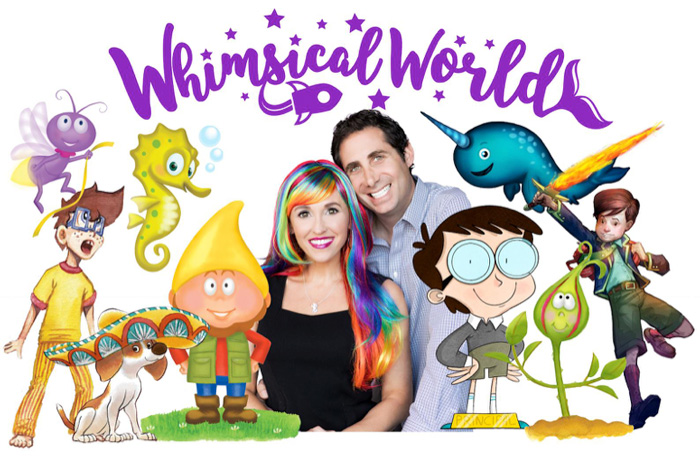
While Sheri’s books tended to focus more social-emotional learning, my books were more geared toward science and linguistic themes, thus by combining our catalogs, we can now offer a library of titles that cover the full spectrum of learning, benefitting both their emotional and intellectual development.
Writing for Preschoolers
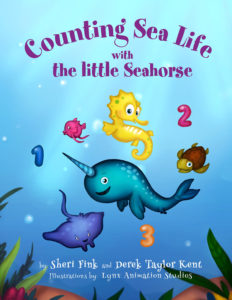 The first book we wrote together was a STEM book for the beginning reader audience (ages 0-4) called Counting Sea Life with the Little Seahorse. With the help of one of Sheri’s beloved characters, the Little Seahorse, toddlers learn to count to 30 while they also discover the incredible variety of life in the ocean.
The first book we wrote together was a STEM book for the beginning reader audience (ages 0-4) called Counting Sea Life with the Little Seahorse. With the help of one of Sheri’s beloved characters, the Little Seahorse, toddlers learn to count to 30 while they also discover the incredible variety of life in the ocean.
One of the most important questions we asked ourselves before writing was: How do we make learning to count both fun and entertaining in a book form, without the advantage of catchy songs like on Sesame Street or flashy games kids can play on an iPad?
From our many years of reading books to young students and family members, we discovered that the keys to holding a toddler’s attention were interactivity, variety, and humor.
For toddlers, reading books is not an activity done in isolation like it is for adults. It is a shared experience with adults. It is a time for discovery, affirmation, and bonding. Thus, by creating interactive elements within the book, the child and parent can bond and affirm discoveries by working together as a team as opposed to being passively read to. With each turn of the page, the child has the opportunity to learn about and count new sea life as well as find camouflaged critters and hidden numbers.
Variety keeps the story fun and exciting as each new page reveals new sea life, replete with vivid colors and rare sea creatures that some adults have never even heard of.
Lastly, humor keeps the tone light and silly and can also spark a child’s imagination. Mine and Sheri’s favorite pages from the book can been seen below. We added elements of the ridiculous with “ninja narwhals” and “tuna in tutus” that catch the reader by surprise and can also spark creativity.
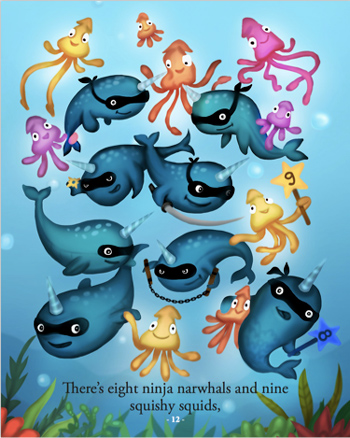
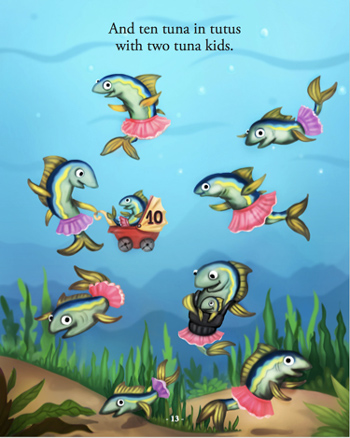
By writing the book in rhyming couplets, Sheri and I aimed to teach kids important lessons about language and the relationship words can have to numbers. The consistent meter is in itself a form of math, so without even realizing it, toddlers make the connection that words and numbers can work in perfect harmony.
Writing for Elementary School
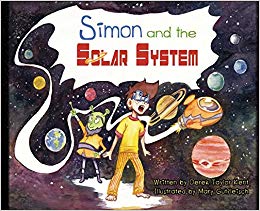 My picture book, Simon and the Solar System, was written for ages 4-9 and operates and a totally different level than Counting Sea Life with the Little Seahorse. Not only is it longer, but there are also advanced scientific concepts that I know the young children will not understand and will therefore spark a discussion between children and parent or children and teacher.
My picture book, Simon and the Solar System, was written for ages 4-9 and operates and a totally different level than Counting Sea Life with the Little Seahorse. Not only is it longer, but there are also advanced scientific concepts that I know the young children will not understand and will therefore spark a discussion between children and parent or children and teacher.
This book tells the story of young Simon Beck, who is terrified to take the next day’s astronomy test because he couldn’t understand the concepts in his textbooks. Luckily for him, a friendly alien named Neil Newton shows up and takes him on a tour of the solar system to give him the up-close learning he needs, but they learn that the solar system can be just as dangerous as it is awe-inspiring.
I actually wrote this book as an extra credit assignment for an astronomy class I took in college, and the character of young Simon was inspired by my hilarious professor, Simon Balm. Needless to say, he loved the book and was delighted to see it finally brought to life not too many years later.
The opening of the book illustrates one of the key points of this article. Textbook learning can be difficult for young students, so finding ways of making a subject like astronomy fun and entertaining can not only help a child learn, but also can inspire them to become a future astronomer like Simon Balm.
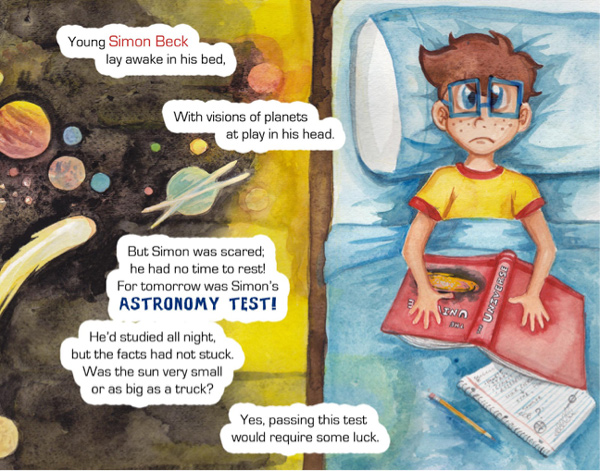
For this book, I was focused on three different elements when appealing to a more advanced age group: story, illustrations, and adventure. The older children enjoy being read to and told a story. Interactive elements can still be used, but they are at the point now where they enjoy having a beginning, middle, and end with characters that change and learn along the way. Simon receives the call to adventure from Neil Newton, and when he accepts it, he is whisked away to the first place he can think of: Saturn’s rings. That’s where things take a turn for the dangerous as they find themselves having to dodge ice rocks and barely escape with their lives.
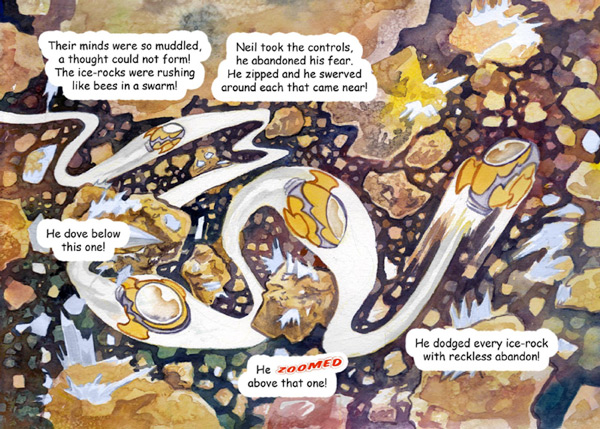
My goal in writing it this way was to teach important facts about Saturn. Most kids probably won’t know yet that Saturn’s rings are actually made of countless chunks of rocks and ice that only appear as solid rings because of a cosmic optical illusion. But I don’t have Neil Newton simply fly to the rings and tell Simon those facts and then have them fly to the next place. The reader learns all of this through story by having them accidentally teleported into a dangerous area of the rings and having to dodge them in the spaceship. The reader effectively becomes an expert on the Saturn’s rings simply by following the story and seeing the illustrations without ever having to be told a single fact. Since stories are much more sticky in the brain than lectures, there’s not a chance any kid who has ever read this section of book will ever forget what Saturn’s rings are made of.
Having eye-popping illustrations is another way to grab the young reader’s attention and interest. I was lucky enough to work with an incredible artist named Mary Gutfleisch (Mary Doodles on YouTube), who hand-painted each illustration in watercolor and won a Best Illustrations in a Picture Book award for her efforts. Whereas words in a textbook and lectures from a teacher are important, pictures really do speak a thousand words when it comes to understanding science and nature. I could sit down and tell a kid everything I know about Mars, but seeing young Simon actually walk on its red rocky surface is far more captivating.
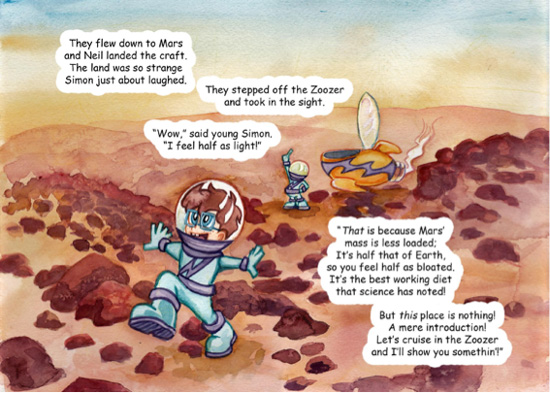
Writing for Middle-Grade
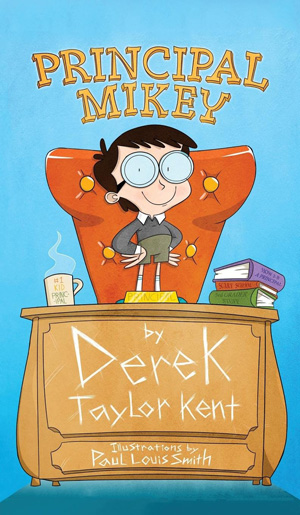 My latest chapter book novel is called Principal Mikey. It’s about a ten-year-old kid who is so adept at solving problems, he gets the opportunity to be principal of his school when the actual principal goes on leave.
My latest chapter book novel is called Principal Mikey. It’s about a ten-year-old kid who is so adept at solving problems, he gets the opportunity to be principal of his school when the actual principal goes on leave.
I knew that I wanted to write a STEAM-focused chapter book, but I was very concerned it would be too tedious and preachy for fickle eight- to twelve-year-old readers who are used to reading books like Diary of Wimpy Kid or Captain Underpants for pure entertainment value. I hoped to teach kids the scientific method and inspire a love of science while remaining fun and keeping my signature brand of off-the-wall humor.

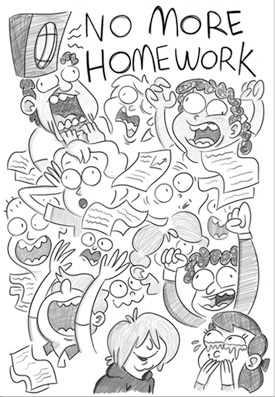
I struggled for a long time about how to do this, until I realized that the obvious next step was simply to show my audience science in action. After learning about STEAM concepts in Counting Sea Life with the Little Seahorse and Simon and the Solar System, it was now time to show kids how science can be used in everyday life to make the world a better place. This, I thought, would be exciting for the reader.
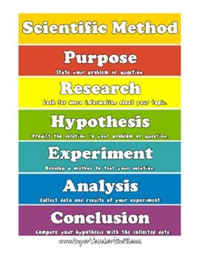 In the very first chapter Mikey solves a neighborhood problem of frequent car accidents on a nearby street by using the scientific method.
In the very first chapter Mikey solves a neighborhood problem of frequent car accidents on a nearby street by using the scientific method.
In later chapters, he uses science to solve increasingly complex problems, including a school-wide flu epidemic, low student morale, and even the imminent closure of the school due to poor standardized test scores.
However, those problems are practically a cinch compared to the emotional dilemmas he’ll need to come to terms with, like alienating his best friend and having to possibly expel his own sister. In the end, I realized that my wife’s lessons in social-emotional learning, such as how be a good friend, a good sibling, and just a good overall person are equally important life skills as the most advanced calculus and more rewarding than an A on a report card.
—
About the Author
Derek Taylor Kent is the author of the award-winning middle-grade series Scary School, published by HarperCollins, the best-selling bilingual picture book, El Perro con Sombrero, from Holt/Macmillan, and the puzzle-thriller Kubrick’s Game through Evolved Publishing. He created the children’s brand Whimsical World with his wife, Sheri Fink, and under that banner has released Principal Mikey, Simon and the Solar System, Counting Sea Lie with the Little Seahorse, and the upcoming bilingual picture book Doggy Claus/Perro Noel coming November 13, 2018.
You can learn more about Derek Taylor Kent and his books at www.DerekTaylorKent.com.
For information on Whimsical World and to purchase autographed and personalized books, please visit www.WhimsicalWorldBooks.com.
Follow Derek and Sheri
Whimsical World: Instagram | Facebook | Twitter
Derek Taylor Kent: Instagram | Twitter
Sheri Fink: Instagram | Twitter
Discover more articles Derek Taylor Kent’s Full S.T.E.A.M. Ahead! The Art of Making Educational Books Fun and Entertaining on The Children’s Book Review by following along with our articles tagged with Art Of Writing, Derek Taylor Kent, STEM, and Writing Tips.

